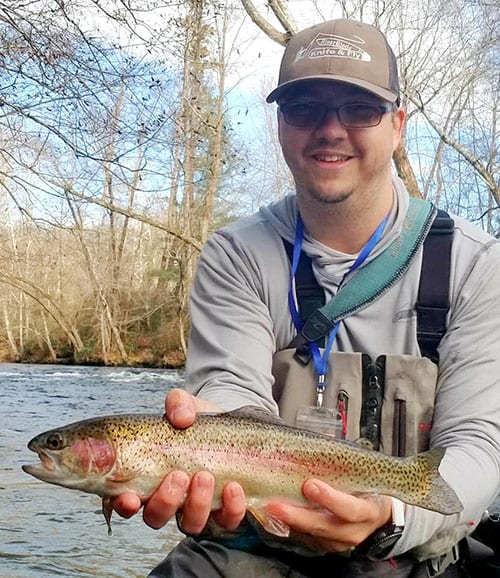One rule of thumb that I have for trout fishing in the winter is to never leave the house without plenty of split shot. I discovered, over the many years of chasing this cold water fish, that the majority of them are content to be lazy and hold right near the bottom of a river as the water temps drop. Probably a variety of reasons for this, but I have suspected that it is a combination of the fish’s metabolism slowing and the fact that the bug activity in our rivers is also not at the level of the warmer weather months. That being said, I always seem to catch more fish this time of year when I make sure my offerings are getting very near the bottom of the river, which usually means adding split shot to my leader.
On my most recent trout fishing outing, I was joined by one of my fishing buddies who had not been able to trout fish for quite some time. As we arrived at the river, we noted that the water levels were certainly higher than normal, and realized that we were likely going to have to wade downstream with the current in order to cover water. My fishing buddy likes to throw streamers when he fly fishes for trout, which works well in this scenario because streamer fishing is typically a downstream presentation anyway. Baitfish, crawfish, leaches, sculpins and the like, are all able to swim around in a river in any direction they want, as they are not at the mercy of the current. Any fly pattern that mimics these things is categorized as a “streamer” and is typically cast downstream and then worked back against the current, looking like something struggling to swim upstream. This is a tempting meal for a trout, but usually only the more aggressive fish that are willing to chase a meal down will take it. I decided to take a different approach just so we wouldn’t be showing the fish the same thing. Because the water was running high, I tied on a rather large stonefly nymph pattern and one of my old standbys for high water, a worm pattern. Of course, the next thing to do was add some split shot to get them near the bottom.
Stoneflies and worms are things that are at the mercy of the current, meaning they don’t swim upstream or across a river; the proper technique here is to dead drift them as naturally as possible in the currents. Typically, this is achieved by casting upstream and then managing your fly line as the currents carry your flies downriver to waiting trout. I positioned myself along the shallower side of the river and began making my casts at an angle, upstream and across from my position. As my luck would have it, it only took a few drifts before I had my first hookup of the day, a nice feisty rainbow trout that measured out around 15 inches. I always like to fish two flies in tandem, showing the fish two different things and letting them tell me what they are in the mood to eat. As the next hour or two passed, and another 10 to 15 fish brought to the net, I discovered that the majority of them were taking the worm pattern. I decided then, as I took a few minutes for lunch, that I would just fish with two different worm patterns for the remainder of the day. That turned out to be the correct call, as I caught numerous fish during the afternoon and they were taking both of the worm pattern flies I was throwing. And of course, don’t forget the split shot.
Brandon Barber is the owner of RiverBlade Knife & Fly Shop in Spartanburg, South Carolina.
